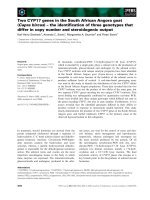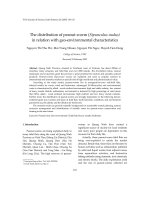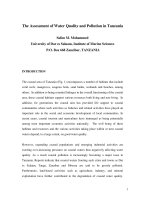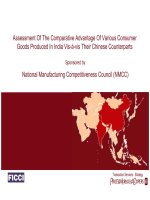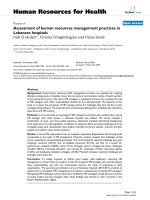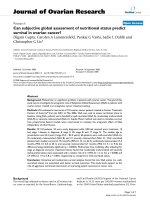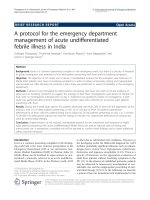Assessment Of The Comparative Advantage Of Various Consumer Goods Produced In India Vis-à-vis Their Chinese Counterparts pptx
Bạn đang xem bản rút gọn của tài liệu. Xem và tải ngay bản đầy đủ của tài liệu tại đây (2.57 MB, 182 trang )
Assessment Of The Comparative Advantage Of Various Consumer
Goods Produced In India Vis-à-vis Their Chinese Counterparts
Sponsored by
National Manufacturing Competitiveness Council (NMCC)
Transaction Services - Strategy
PricewaterhouseCoopers and FICCI have taken all reasonable steps to ensure that the information contained herein has been obtained from reliable sources and that this publication is
accurate and authoritative in all respects. However, this publication is not intended to give legal, tax, accounting or professional advice. No reader should act on the basis of any information
contained in this publication without considering and, if necessary, taking appropriate advice upon their own particular circumstances. If such advice or other expert assistance is required, the
services of a competent professional should be sought.
This publication (and any extract from it) may not be copied, paraphrased, reproduced, or distributed in any manner or form, whether by photocopying, electronically, by internet, within another
document or otherwise, without prior written permission . Further, any quotation, citation, or attribution of this publication, or any extract from it, is strictly prohibited without prior written
permission
2
. [
Â
V.Krishnamurthy
Chairman
Government of India
[ [ì
National Manufacturing Competitiveness Council
FOREWORD
The growth in developed western markets has slowed down; consequently a large number of global players are increasingly looking towards developing markets like India
and China for their future growth. Countries like India and China not only offer a huge untapped domestic market but also have the advantage of keeping the manufacturing
costs much lower.
Consumer durables constitute an important segment of the manufacturing sector. Prior to liberalization of the economy, consumer durables sector in India was restricted to
a handful of domestic players who had a combined market share of 90%. With liberalization a spate of foreign players has come to operate in India. Most of them are
strengthening their presence in India, expanding their reach to Tier 2 markets with some of them setting up production facilities in India as well.
However, for most players China remains the global sourcing and manufacturing hub for consumer durables. For instance, China accounts for 72% of the global air
conditioner production, 47% of refrigerator production, 45% of television production, 35% of washing machine production and over 52% of mobile phone production. If India
wants to play a larger role it has a vast scope for improving its share in the world market.
Keeping this back drop in view, the National Manufacturing Competitiveness Council (NMCC) commissioned a study through PricewaterhouseCoopers Pvt. Ltd. (PwC) and
the Federation of Indian Chambers of Commerce and Industry (FICCI) to assess the comparative advantage of manufacturing consumer durables across six product
categories in India and China.
The study encompasses analysis of macroeconomic and production specific factors that impact consumer durable manufacturing sector in India and China. The various
aspects covered in the study market dynamics, FDI inflows, development of infrastructure, SEZs, Government incentives, cost structure, duties and tax rates. The PwC
and FICCI analysis is based on comprehensive review of secondary literature as well as extensive primary research including interviews with a number of consumer
durable manufacturers and industry representatives in both the regions.
It is hoped that the study report will provide an understanding of the true competitiveness of the consumer durable manufacturing sector in India vis-à-vis China and help
the industry and the Government to chalk out a roadmap for India’s emergence as a major global player in this field.
4th August, 2009
V.Krishnamurthy
Chairman, 3NMCC
Table of Contents
Page
1 Executive summary
6
2 Introduction
11
3 Consumer durables – market overview
15
3.1 Demand drivers in China and India
22
3.2 Industry players
29
3.3 Mobile phones growth story in India
31
4 Analyzing China’s growth
4.1 Macroeconomic factors
35
36
FDI inflows
40
Special Economic Zones
43
Infrastructure and Utilities
47
Technological development
50
Low cost environment
57
Export competitiveness
65
4.2 Production specific factors
68
Representative value chain analysis
5 Recommendations
89
92
4
Table of Contents
Page
Appendices
1 Chinese policies and WTO
114
2 Electronics industry in other countries
121
3 Tax
127
4 Haier case study
136
5 Key Chinese player’s profiles
145
6 SEZs in China: Additional details
151
7 Trends in consumer durables
156
8 Others
162
9 Bibliography
169
10 Glossary
176
5
Executive summary
Section 1
Section 1 - Executive summary
Executive Summary
China has emerged as a low cost manufacturing destination for consumer durables catering to both domestic and export
markets. 54% of the production in China (for the six categories under consideration) caters to the export market.
Domestic sales in India are a miniscule proportion of that in China and export volumes are not even 1% of that in China
•
Value in USD billions
While for some of the product categories like televisions, India has a cost
advantage in the low end segments, consumer prices in China are at
minimum 15 – 25% cheaper when compared to prices in India (for similar
features), leading to a higher demand base in China
•
Also, Indian consumer durable market is mostly dominated by MNCs
while China has a large number of home grown domestic players
To
ys
e
In comparison, export volumes in India are not even 1% of that in China
across these six categories. Domestic sales in India are a small
proportion of that in China in most of the six categories
i le
ob
M
as
hi
Te
le
v
ph
on
is
io
n
hi
ne
ac
m
ng
r ig
ef
R
•
W
Ai
rc
on
di
tio
er
at
ne
or
r
Volumes in millions
60
50
40
30
20
10
0
700
600
500
400
300
200
100
0
China has also emerged as an export base with most domestic and
foreign players in China using the low-cost facilities in China to cater to
global markets. 54% of the total production in China for the six categories
under consideration are exported. The undervalued currency has aided
China’s growth as an export base
•
P roduction sna pshot
China - V olumes
India - V olumes
China - V alue
India - V alue
•
A large number of global players are targeting emerging markets to fuel
growth. Due to increasing price competitiveness, outsourcing
manufacturing to low cost destinations has gained momentum
•
China has emerged as one of the most popular low-cost manufacturing
destinations of this outsourcing trend
•
•
It accounts for 72% of the global air conditioner production, 47% of
refrigerator production, 45% of television production, 35% of washing
machine production and over 52% of mobile phone production
Most of the major global players in the consumer durables segment have
set up their manufacturing operations in China
Key reasons for Chinese dominance in the global consumer durable
market are two-fold:
• Macroeconomic factors and policy initiatives that have provided
impetus to overall manufacturing in China
• Production specific factors which have provided China with a cost
advantage and aided its growth as a export base for consumer
durables
Prices have not been adjusted for PPP
7
Section 1 - Executive summary
Macroeconomic factors
Starting from almost similar levels of GDP in early 1970s, China’s GDP is currently three times that of India. This growth
has been primarily driven by manufacturing. FDI inflows, SEZ policy and its effective implementation, infrastructure
investments and Government incentives focussed on manufacturing have been the key growth drivers in China
Factors
China
India
FDI inflows
China attracted huge FDI inflows with net FDI inflows in 2006-07 amounting to
USD 69.5 billion. This has aided technology transfer, vendor base development
and adoption of best practices by domestic Chinese firms
FDI in China is mostly export oriented in order to take advantage of the low
cost environment
India opened up its economy much later than China during 1990s
and has lagged behind China in attracting FDI. Net FDI inflows in
2006-07 amounted to USD 16.8 billion
FDI in India (at present) is mostly oriented towards meeting
burgeoning domestic demand
SEZs
China has 54 SEZs which have been successful in attracting FDI investments,
serving as export bases and generating employment
Flexible labour laws, strategic locations and a well formulated policy along with
its effective implementation are the key reasons for their success
In India, SEZs are yet to take off with a critical mass. Though
India has about 250 small SEZs, they have not been as successful
as the Chinese SEZs in increasing manufacturing related exports.
Many others have been notified/approved but yet to be set-up
Infrastructure
Infrastructure is not yet on par with developed countries. However, there have
been huge focussed investments on improving ports, railways and roadway
infrastructure
China ‘s spend on infrastructure development is pegged at 10% of its GDP
India spends 5% of its GDP on infrastructure
It is estimated that the infrastructure sector will require investment
of USD 500 billion between 2007 and 2012 in order to sustain
India’s growth
Government
incentives
Government incentives to develop manufacturing sector in China include
favourable tax policies, grants and subsidies specifically aimed at boosting
exports. For instance, the Chinese Government is estimated to have provided
subsidies totaling USD 79.1 billion to the steel industry which helped the
industry to become a net exporter from being a net importer
India does have incentives like export financing and other
incentives at SEZs, but the Government incentives have not been
sharply focussed on manufacturing as in China
Capital costs
China has had a low interest rate environment which has spurred investments.
State owned banks have been funding investment to the industry through
loans, which in large parts are not repaid
India has had higher borrowing costs than China. This is
discussed in detail in later sections of this report
Technological
Development
China has the second largest R&D investment in the world. Having R&D
centers in China helps multinationals build relationships with the local and
national Government which in turn facilitates business
High end technology exports in India are 1/60th of that in China
8
Section 1 - Executive summary
Production specific factors
Demand for consumer durables being highly price elastic, China’s distinct cost advantage and lower prices have led to
higher domestic demand and boosted export sales. Some of the factors leading to Chinese cost advantage are lower
raw material costs, higher labour productivity, lower level of indirect taxes and import duties
•
Raw material/Component sourcing costs: Raw material costs are lower
in China with 55 – 90% of the components being sourced domestically.
In India, most of the components are imported
•
Also steel prices (which is a key raw material) in India are 30 – 35%
higher than in China while aluminium prices are about 7% higher on an
average (Discussed in detail in the later sections of the report)
•
Labour costs: Labour costs have been on a rise in China and is currently
at 1.5 times that of India at lower levels. China is also recording a wage
inflation of about 15 - 20% per annum
Indirect taxes: Effective indirect taxes in China are lower than that in
India. China has a single indirect tax comprising of 17% VAT while India
has multiple indirect taxes like excise, VAT and education cess which
lead to an effective rate of 28.7% for consumer durables and 19% for
mobiles and toys
•
Import duties: For majority of critical components (in consumer durables
and toys) the import duty in India is higher in comparison to China.
Further, since India does not have a well developed component
manufacturing base, most of the components are imported
•
The effective import duties in India are in the range of 4 – 31.7% while
Chinese effective duty rates are in the range of 0 – 6%
•
Utility costs: Power costs vary across regions in India and China,
Indicative power cost per 1000 kwH in China is around USD 73
compared to USD 97 for India. Moreover quality of power in terms of
power outages is poorer in India than in China
•
Water costs for industrial use in China are in the range USD 0.19 – 0.9/
kl compared to USD 0.175 – 1.5 /kl in India
Further, lack of economies of scale, absence of an eco system of
suppliers and infrastructure bottlenecks have constrained the growth of
component manufacturing in India
•
•
•
Although average wage rates seem to be lower in India, China’s labour
productivity on an average is around 1.8 times that of India and has
consistently shown an uptrend
•
Logistics and transport costs: While most of the manufacturing locations
in India are spread out due to location specific tax benefits,
manufacturing locations in China along with the vendor base is clustered
(with most located near the east coast), reducing logistics costs and
aiding exports.
•
Average freight cost in China is USD 0.013 per tonne per km compared
to USD 0.2 in India
YoY inflation as calculated for hourly wage rates over last 5 years,
Source: Euromonitor
Indicative power cost calculated as an average across usage bands
9
Section 1 - Executive summary
Recommendations
DECREASING ATTRACTIVENESS OF CHINA
• The Chinese Government has started to shift its focus from
export driven growth to increasing domestic consumption and
has hence removed a number of export subsidies, tax rebates
and abolished preferential tax rate for foreign companies
• The domestic market in China is saturated on account of high
penetration levels
• Currency appreciation, shortage of skilled labour along with
rising wage inflation, and increasing real estate costs are
eroding the cost competitiveness and hence the export
competitiveness of China
OPPORTUNITY IN INDIA
• Growing demand from Indian consumers fuelled by growing
population, rising incomes and changing lifestyles
• Huge untapped market and the need to be closely located to
consumers along with potential to cater to export markets from
India
• High availability of skilled manpower that can be employed for
high-end research and development activities
LEVERAGE BY PROVIDING IMPETUS IN FORM OF CONDUCIVE POLICIES
Decreasing attractiveness of China as a manufacturing destination in recent years is an opportunity for India. In order to
leverage this opportunity, developing a conducive manufacturing environment with particular focus on component
manufacturing is critical for India
SUGGESTED RECOMMENDATIONS
• Promote technology development through tax exemptions for R&D
centers and VC funding, promoting tie-ups between the industry and
technology institutes as well as promoting technology transfer through
FDI
• Develop SMEs by promoting cluster development and creation of
common service centers for use by SMEs, changing incentives for
SSIs to be time bound rather than turnover based and creating
technology acquisition funds for SMEs
• Rationalize the tax policy through removal of tax for interstate
movement of goods and removal of location based incentives
• Incentivize domestic value addition by promoting local sourcing.
Increase the demand base by incentivizing exports
• Develop vendor base and raw material supply by providing priority
sector treatment to component manufacturing; Provide support for
capital intensive component manufacturing facilities by providing rentto-own facilities
• Develop SEZs by promoting large multi-product SEZs, providing
flexible labour laws, and tax exemption for sale in DTA
• Other recommendations include reducing financing rates, reducing
logistics time by ensuring round the clock customs clearance and
implementing automated cargo processing
• Each of these are discussed in detail in the later sections of the report
10
Introduction
Section 2
Section 2 - Introduction
Scope of Study
This study focuses on six consumer durable product categories - Television, Refrigerator, Washing machine, Room air
conditioner, Toys and Mobile phones
The study covers the following broad aspects:
•
Overview and assessment of identified consumer durables sectors in
India and China :
–
Key trends, major players and market dynamics
•
Analysis of production environments in India and China
•
Key enablers and barriers for manufacturing consumer durables in India
vis-à-vis China
•
•
Television
–
Excluding Black and White televisions
•
Refrigerator, Washing machine and Air conditioners
•
Toys
Analysis of essential conditions and policy inputs in India and China
which result in competitive advantage
•
The scope of work involves the following six product categories:
Recommendations and guidelines for sustainable competitive advantage
of Indian companies
–
•
This includes only traditional toys
Mobile phones
Traditional toys are defined as objects of play, typically for children, which does not involve a video game component
12
Section 2 - Introduction
Our Approach and Methodology
We have used multiple sources and selective rigorous analysis to arrive at our conclusions
Issue identification
and
project management
Research
Conclusions /
Presentation
Analysis
•
Identify companies for research
•
Market assessment and review
•
•
Work plan definition
•
Information from independent
external sources & Interviews
with sector experts
Main analyses covering both
markets.
•
Market demands and trends
•
Production environment
•
Trade press and trade
organizations
•
Information from market players
& key Interviews
•
Presentation of report with
analysis and recommendation to
NMCC
Key market players and their
assessment of the production
landscape
•
•
Cost base and pricing structures
•
Preparation of the final report
Various policy aspects
•
•
Financial viability,
incentives,concessions, tax
payable & others
All analysis in this report are based on data / information gathered before July 2008 unless otherwise explicitly stated
13
Section 2 - Introduction
Report structure
The report includes a comparative analysis of India vis-à-vis China on the historic economic growth and manufacturing
environment for the six product categories under consideration
GLOBAL SCENARIO FOR CONSUMER DURABLE
-
SECTION LEFT INTENTIONALLY BLANK
Analysis of global trends in the consumer durable industry
CONSUMER DURABLE INDUSTRY IN INDIA AND CHINA
-
Comparison of the market across all six categories in India and China
ANALYZING CHINA’S GROWTH
-
Analysis of the growth of manufacturing in China including both
macroeconomic and production specific factors
WHAT CAN WE LEARN FROM CHINA?
RECOMMENDATIONS
• Key policy recommendations specific to the consumer durable sector
ELECTRONIC CASE STUDY
• Key learning for India from other countries in the electronics
component manufacturing space
14
Consumer durables –
market overview
Section 3
Section 3 - Consumer durables – market overview
Global home appliances
The global home appliance market, estimated at USD 195 billion is mainly concentrated in Europe and North Asia
Ge ogra phica l Distribution
Globa l Industry Re ve nue s [ In US D Billions ]
1%
3%
1%
1%
3%
250
CA GR = 7%
200
11%
41%
150
100
50
0
2003
39%
2006
2007
North A s ia
North A meric a
South A merica
India and Central A s ia
Oc enia
2005
Europe
South Eas t A s ia
2004
A f ric e and Middle Eas t
Source: Ibisworld
Source: Ibisworld
KEY FACTS
•
The household appliance industry which includes air conditioners,
refrigerators and washing machines is one of the largest segments in the
consumer durable industry with the world market valued at USD 195
billion
•
Close to 80% of the market is concentrated in Europe and North Asia
The home appliances industry employs over 0.8 million people globally
In all there are over 10,000 enterprises in the home appliances industry
Employee wages and salaries totalled over USD 24 billion (value
expressed in constant 2007 prices)
Source: Press release
16
Section 3 - Consumer durables – market overview
Global scenario for television, mobile and toys
Rapid technological advancements and continuous introduction of newer models have led to growth in mobile and
television industry
KEY FACTS
TOYS
TOYS
Globa l Re ve nue s
•
The global toys and games market grew by 7.2% in 2007 to reach a
value of USD 106.1 billion. Sales of traditional toys account for 58.2%
of the global toys and games by market value
•
The market is increasingly moving away from traditional toys to video
games and other electronic toys
160
CA GR = 17 %
140
CA GR = 19 %
120
In USD Billions
TELEVISION
TELEVISION
100
•
80
CA GR = 6 %
The global television market is estimated to be around 187.4 million
units in volume terms and USD 119 billion in value terms
•
Technology changes from CRT to plasma and LCD have fuelled the
growth of televisions in the recent past
60
40
MOBILE PHONES
MOBILE PHONES
20
2003
Telev is ions
2004
Mobile phones
2005
2006
Traditional toy s and games
2007
The global market for mobile phones in 2007 is estimated to be around
1.05 billion units in volume terms and USD 147 billion in value terms
•
Technology convergence is increasing demand for mobile phones
•
0
2002
•
Western Europe saw the highest volume sales in the portable
consumer electronics , mainly comprising of mobiles
Source: Euromonitor, Bureau of Statistics (China)
Bureau of Statistics (China), Euromonitor
17
Section 3 - Consumer durables – market overview
Trends in the Global Market
Large number of global players are targeting emerging markets to fuel growth. Outsourcing manufacturing to low cost
destinations has gained momentum on account of increasing price competitiveness
•
Developed countries
Rising per capita incomes, low penetration levels and saturated markets
in the developed countries have led to a shift in focus towards emerging
market
•
Product quality improvements in recent years have also lead to longer
product lives, thereby reducing the replacement demand in the
developed markets
•
Also in case of toys, developed economies which were traditionally
strong markets for toys and games, are experiencing falling birth rates
leading to an inevitable shrinking of the target segment of children and
infants
•
House hold P e ne tra tion
Many existing manufacturers have rationalized the number of plants, and
outsourced production to third party manufacturers in low-cost countries
like China
•
Other trends that are noticed in all 6 categories in general include:
India
100
P ak is tan
80
V ietnam
60
Nigeria
Developing countries
40
US A
United K ingdom
20
S ingapore
0
AC
Source: Euromonitor
Micro
Ov en
Ref ri gerator
Washing
Mac hine
A us tralia
Country
Large Players in Domestic Market
US
Top 4 appliance manufacturers are estimated to account
for 80% of the domestic market
Europe
Top 4 manufacturers account for a large share of
production in western Europe
China
Haier and Nokia have a major share
Turkey
Arcelik controls over 60% of the market
France
Group SEB is estimated to have a market share of 63% for
mixers
India
LG and Samsung have a major share in the market
–
Fall in unit prices in real terms
–
Industry characterized by moderate technological advancements.
Exception includes televisions where the demand has risen due to
the radical LCD technology
–
Few large players occupy dominant positions in the market
due to the scale driven nature of the industry. Manufacturers
with scale are more likely to be in a better position to negotiate with
suppliers on price and also be in a better position to reduce
transport and logistics cost per unit sold
.
18
Section 3 - Consumer durables – market overview
Production in China
China has emerged as a major beneficiary of the outsourcing trend and accounted for over 24% of global production of
household appliances by value, 45% of television manufacturing and 52% of mobile phone output
Chinese production as a percentage of total global production
OEM PLAYERS WITH A
MANUFACTURING BASE IN CHINA
EXPORT ORIENTED
PLAYERS FROM CHINA
Player
Country
Japan
BenQ
Indesit
Italy
AU Optronics
Samsung
South Korea
Haier
Philips
Netherlands
Compal Communications
Mattel
US
Quanta
Daikin
Japan
Pantech
Siemens
Germany
Arima
Sanyo
Japan
TPV Technology
Samsung
Korea
Konka group
LG
Korea
TCL
Electrolux
Sweden
Sharp
Sony
Japan
Chi Mei Optoelectronics
Nokia
Finland
52%
45%
50%
Galanz
Panasonic
60%
Hannstar Display Corp
40%
30%
24%
20%
10%
0%
Source: PwC Analysis
Household Appliances
Television
Mobiles
Source: Ibisworld, Press Releases, PwC Analysis
•
A number of manufacturers set up operations in China in order to take
advantage of the low cost environment (to develop it as an export base)
and its large domestic market
•
The table alongside shows a representative sample of manufacturers
from across the globe who leverage China as a manufacturing base and
also manufacturers from China who serve as OEM vendors for other
foreign companies
•
The following slides discuss the difference in production volumes in India
and China, and the key demand drivers that have led to this difference,
followed by an analysis of key players in each product category
•
We also specifically look at the mobile phones industry in India as
contrary to other product categories, mobile phones grew at a
phenomenal rate and hence makes for an interesting case study from an
Indian perspective
19
Section 3 - Consumer durables – market overview
Production Snapshot
Domestic sales in India are a miniscule proportion of that in China and export volumes are not even 1% of that in China
across product categories
Domestic sales
CAGR
Export Volumes
(In Million Units, 2007)
Product
( over past 5 years )
(In Million Units, 2007)
India
China
India
China
19
11
0.07
36.7
6
13
0.41
16.3
11
10
0.05
13.3
11
4
0.7
47.9
85
26
2.24
483
India
Air Conditioner
1.8
32.1
4.3
Refrigerators
Washing
Machine
Televisions
Mobiles
China
26.8
1.9
21.2
14.6
40.6
88.6
168.0
China accounts for 72% share of world’s RAC manufacturing, 47% of refrigerator manufacturing, 45% of television manufacturing, 35% of washing machine
manufacturing and 52% of mobile output
Source: DGFT, Euromonitor, National Bureau of Statistics of China, ChinaCCM, GfK Research, Ministry of Information Industry of PRC, China Customs, Sino Market Research, Ministry of
Commerce of PRC, White book of China’s Refrigerator Industry (2006), CrisInfac, PwC Analysis
20
Section 3 - Consumer durables – market overview
Import Content
While China barely imports CBUs across these product categories, India imports nearly 1/3rd of Air-conditioners and
1/4th of washing machines as CBUs
•
Imports of CBUs across product categories
Product Categories
India
China
Air Conditioners
31%
<1%
Refrigerators
2%
<1%
Washing machines
23%
<1%
Colour Televisions
10%
<1%
Mobiles
N.A
<1%
Toys
38%
The imports of CBU across the chosen product categories by China is
considered negligible
<1%
Source: DGFT, Euromonitor, CRISIL, National Bureau of Statistics of China, ChinaCCM, GfK
Research, Ministry of Information Industry of PRC, China Customs, Sino Market Research,
Ministry of Commerce of PRC, White book of China’s Refrigerator Industry (2006), CrisInfac,
PwC Analysis
21
Demand drivers in
China and India
Section 3.1
Section 3.1 - Demand drivers in China and India
Consumer Price Level
Consumer prices in China are at minimum 15 - 25% lower compared to the prices in India which has led to higher
domestic demand. For the high end LCD TV, India does not have the capability to produce LCD panels and most of the
panel requirement is imported, resulting in high prices of LCD TVs in India as compared to China
China
High End
India
Representative Product Explanation
Mobile
Was hing Machine
0.86 x
TELEVISION
•
India is cost-competitive with China in the low end, especially CRT TV segment
because most of the demand in India originates from this segment and hence
manufacturers are able to achieve economies of scale
•
Due to continued price cuts in the CRT TV segment and reducing margins,
players are increasingly shifting focus to higher-end televisions
•
For high-end LCD TV’s, India does not produce LCD panels and most of the
panel requirements is met through imports resulting in high prices of LCD TVs in
India as compared to China. Also , LCD TV sales are still low in India to achieve
significant economies of scale
Ref rigerator
TV
AC
M e dium
Mobile
Washing Mac hine
0.85 x
MOBILES
Ref rigerator
•
The consumer price levels in China and India are almost the same with China
faring better in a few cases. This is mainly because mobile component imports
do not attract customs duty in India and freight costs as a percentage of
consumer price (per product) is low
•
In the low-end category of phones, India is competitive due to the economies of
scale on account of presence of a large number of low end mobile
manufacturing facilities; The huge demand in this segment also leads to
economies of scale
•
A number of players are developing low end phones with sub USD 30 prices,
specifically for emerging markets like India, leading to a downward trend in
mobile phone prices
TV
AC
Low End
Mobile
Washing Machine
Ref rigerator
TV
AC
Source: Interviews, PwC Analysis
0.74 x
Price levels are not PPP adjusted
Refrigerator is not included in the average rate comparison. The comparison was done
solely based on the litre capacity as a specification. A similar capacity refrigerator in
China would have a host of value added features such as LCD touch screen, higher
freezer to refrigerator ratio etc and hence be priced higher than in India
PwC Interviews
23
Section 3.1 - Demand drivers in China and India
Trends in average price levels
While the average price levels are lower in China for Air conditioners, the price levels in China are higher for
refrigerators and washing machines mainly due to consumer preferences for high end models; Overall the industry is
characterized by high pricing pressure and hence the need to minimize costs
China
India
Product
Trends
Details
While 1.5 ton ACs are the most popular variant being sold in India, 1 ton ACs which
are cheaper remain the most popular variant in China, leading to lower average
prices in China
2007
2006
Air Conditioner
Prices of Room Air Conditioners (RAC) in India dropped in 2005 due to FTA with
Thailand ( duty rates were reduced by 75%)
2005
2004
0
100
200
300
USD
400
500
600
Change in consumer preferences during the period 2005-07 towards split AC with
better price realizations (compared to conventional window AC) has led to an
increase in average prices
2007
The average refrigerator prices in India during 2002-07 have remained stagnant and
the value growth has been mainly driven by volume growth
2006
Refrigerator
2005
A shift in consumer preferences towards high end refrigerators in China has led to
increase in average price levels
2004
0
100
200
USD
300
400
2007
Consumer preferences have changed across both India and China. The product mix
has shifted towards fully automatic and higher capacity washing machines
2006
Washing Machine
2005
The average unit price in both India and China has been rising over the last few
years on account of consumer preference for newer features
2004
0
50
100
150
USD
200
250
300
Average price was arrived by taking the ratio of total sales by total volume in the country
Public Information
Crisil
CrisInfac
PwC analysis
24
Section 3.1 - Demand drivers in China and India
Trends in average price levels
The average price levels in televisions are rising due to consumer preferences towards high end models in both the
countries. Due to lower tax rates and large players like Nokia setting up manufacturing units ( both for serving domestic
market and exports) the prices of entry level models and low end phones have reduced significantly in India
China
Product
Trend
Reasons
2007
Consumer preference has changed both for India and China. The product
mix has shifted towards high-end models, such as plasma display panels
(PDP), liquid crystal displays (LCD), digital light processing (DLP), highdefinition television (HDTV), and flat-panel TVs
2006
Television
2005
The average unit price in both India and China has been rising over the
last few years on account of this shift
2004
0
100
200
USD
300
400
The price has fallen both for India and China, which has led to the volume
growth. Prices have fallen by 21% CAGR in India over the period 200407 compared to 4% for China
2007
2006
Mobile
India
Sales volume in India is mainly dominated by low end phones. Due to
lower tax rates and large players like Nokia setting up manufacturing
units, both for serving domestic market and exports, the prices of the low
end phones have reduced
2005
2004
50
70
90
USD
110
130
Average price was arrived by the taking the ratio of total sales by total volume in the country
Crisinfac, Sino Market research
PwC Analysis
25

